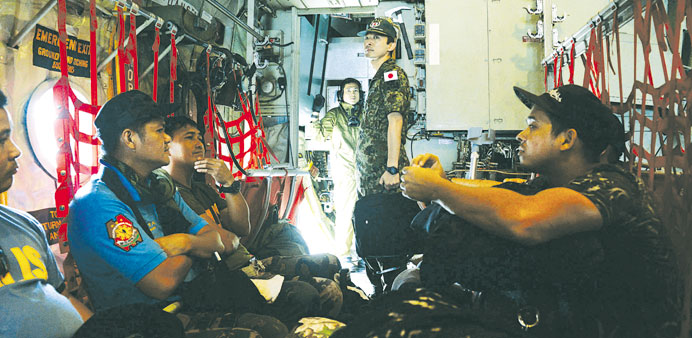Japanese air force personnel shuttle evacuees and police in a C130 cargo plane at Tacloban yesterday.
AFP/Tacloban
More than 1,000 Japanese troops were offered a warm welcome in the Philippines yesterday as they prepared to launch relief operations across typhoon-devastated islands that were brutally occupied by Japan seven decades ago.
The troops were aboard three vessels that arrived at the central Philippine port of Cebu on Thursday night, an official at the Japanese embassy said, in what is the biggest overseas deployment of Japan’s military since its defeat in World War II.
They will join a huge international relief effort to help survivors of Super Typhoon Haiyan, which flattened dozens of towns through the central Philippines on November 8, leaving at least 5,500 dead or missing.
“We have already delivered small amounts of aid but the main effort will begin after a meeting with Philippine forces today,” said Takashi Inoue, deputy director of public affairs with the Japanese embassy in Manila.
Japan’s contribution to the humanitarian effort comes as a newly-confident Tokyo looks to make its mark again on the world order, after decades in which the idea of its troops on foreign soil was complete anathema.
In many parts of Asia, memories linger of the brutality of invading Japanese soldiers prosecuting an expansionist romp through the region in the name of the emperor.
In a twist of historic irony, the Japanese troops are returning to areas of the Philippines that saw Japan lose one of history’s biggest naval battles to the US-led Allies.
Eulalia Macaya, 74, who survived World War II and the typhoon, said she remembered being terrified by Japanese troops as a little girl.
“We were hiding in holes dug under the floor of our homes,” she recalled. “The Japanese soldiers were patrolling but we couldn’t see much of them. We could only see their boots. We were so afraid.”
But Macaya, who was waiting for treatment at a temporary field clinic set up by the Japanese government in Tacloban, the typhoon-ruined capital of Leyte, said she was very pleased the former occupier was back.
“I don’t hold any grudges anymore. There’s no more bad blood between us,” she said.
Tente Quintero, 72, a former vice mayor of Tacloban, said that at a time of dispute with an increasingly emboldened China over the ownership of South China Sea islands, Filipinos now saw the Japanese as friends and allies.
He declared himself “happy” there were Japanese boots back on Philippines soil.
“There’s nothing like two allies living in harmony with each other,” he said. Beatrice Bisquera, 91, said the devastation and hardships Haiyan had brought were worse than anything Filipinos suffered under Japanese military rule.
“During the Japanese occupation we just hid in the mountains. Now, there’s nowhere to hide,” she said.
General Roy Deveraturda, Commanding General of the Philippine armed forces Central Command, said the Philippines was thankful for the Japanese typhoon support, and past animosities were no longer a concern.
“This is a different world. We have seen the generosity of their donation,” he said. “They have already showed remorse. Their help is most welcome.”
For some Japanese relief workers already on the ground in Leyte, their country’s participation in the international relief effort alongside the US is an indication of Japan’s very different relationship with the outside world.
“Nearly 70 years ago, we were enemies. Now we’re friends,” said Joji Tomioka, a doctor helping to coordinate a civilian medical team.
World Bank doubles disaster aid
The World Bank yesterday added $480mn in emergency aid to the Philippines, taking to nearly $1bn its support as the death toll from super typhoon Haiyan passed 5,200. World Bank President Jim Yong Kim made the pledge, added to $500mn committed Monday, in a phone call with Philippine President Benigno Aquino, the development lender said.
The new money will be provided through the bank’s existing Community Driven Development Project for the Philippines, which will allow localities to tap the funds for their own rebuilding projects. “The project will empower communities themselves to lead the reconstruction effort, by offering a transparent way for people to identify their own needs,” the Bank said in a statement. The Bank has already deployed disaster specialists to Manila to help the government assess the damages and identify rebuilding priorities in the wake of the storm, which blasted through the centre of the country on November 8, flattening entire communities and leaving up to fourmn people displaced.
Early estimates by analysts of the typhoon’s economic cost to the Philippines have been put at around $14bn.



